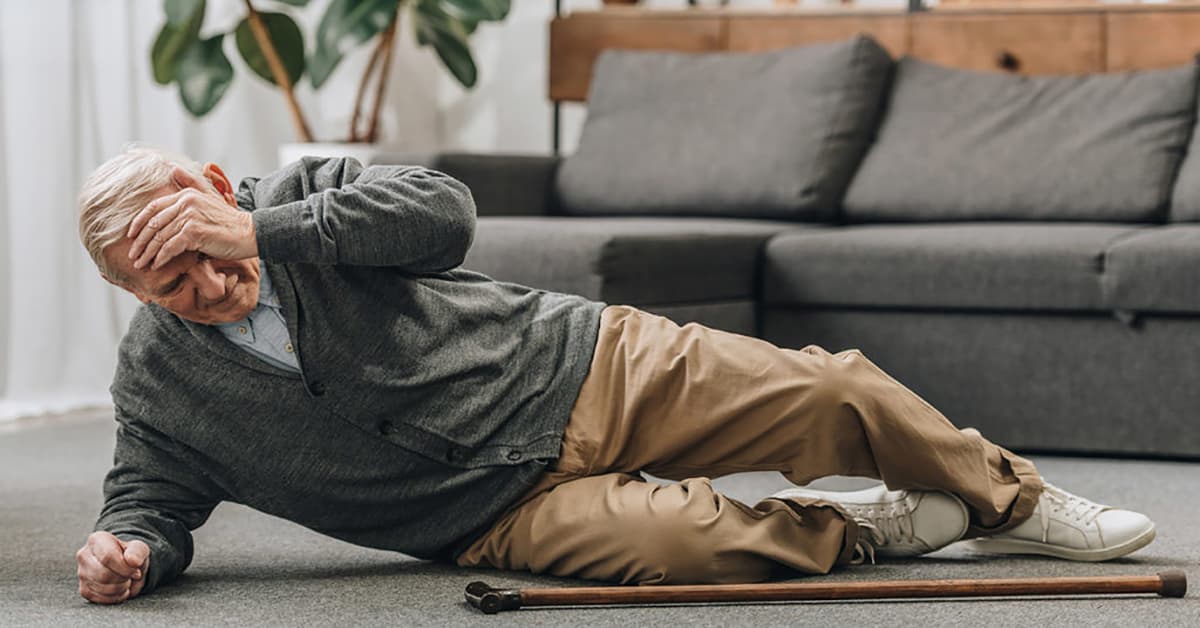The Centers for Disease Control and Prevention (CDC) reports that more than one out of four older adults (65+) fall each year, making falls a legitimate public health concern within this demographic. However, less than half tell their doctor. Additionally, the CDC adds that falling once doubles your chances of falling again.
Risk Factors For Falls
There are a variety of reasons or conditions that contribute to a fall. The good news is some of these risk factors can be modified or changed, to lessen the chances of a fall happening in the first place.
- Home Hazards & Dangers
-
- Steep stairs, broken or uneven steps with no handrails
- Unsecured throw rugs or excessive clutter within hallways or any high-traffic area
- Physical
-
- Lower body weakness
- Challenges with walking & balance
- Foot pain or improper footwear like open-toed sandals, slick soles, or shoes that are too big or small
- Poor vision
- Medicines & Health Conditions
-
- Vitamin D deficiency
- Cognitive decline or a Dementia like Parkinson’s or Alzheimer’s wherein a shuffle-walk may develop
- Taking certain medicines such as tranquilizers, sedatives, or antidepressants. Some over-the-counter medicines can affect balance as well
Most falls are caused by a combination of risk factors. The more risk factors a person has, the greater their chances of falling. Although not all falls cause injury, one out of five falls does cause serious injuries such as a broken bone or head injury. In aging bodies, broken bones or serious injury can impact mobility and their ability to do everyday activities or even live on their own.
Falls Can Be Costly & Serious
Each year three million older adults are treated in the emergency room for injuries due to falls. Over 800,000 patients a year are hospitalized because of a fall injury. Most often, it’s because of a serious head injury, hip fracture or break. The CDC also notes that falls are the most common cause of traumatic brain injuries (TBI).
Per the CDC; Every second of every day, an older adult (age 65+) suffers a fall in the U.S.—making falls the leading cause of injury and injury death in this age group. One out of four older adults will fall each year in the United States, making falls a public health concern, particularly among the aging population.
Each year about $50 billion is spent on medical costs related to non-fatal fall injuries and $754 million is spent related to fatal falls.
For non-fatal falls, the costs break down like this:
- $29 billion is paid by Medicare
- $12 billion is paid by private or out-of-pocket payers
- $9 billion by Medicaid
Keep in mind, that these costs and statistics are based on the cases that are reported and treated. They don’t account for those falls that the older adult doesn’t mention or report.
Preventing the Fall in the First Place
As you recall, most calls are due to a combination of factors. The more risk factors, the higher the risk. Therefore, a first-line-of-defense is to eliminate those things that you can control. Here are some suggestions to consider:
- Assess the Home Environment
-
- Eliminate piles of objects, stacks of boxes or any other clutter that impedes safe movement throughout the home
- Add grab bars to the shower walls and near the toilet. Add them near front doors or other locations to support safe movement where needed
- Consider upgrading to elevated/heightened toilet seats
- Add non-slip mats or strips to the bathtub and shower floors
- If there are stairs, update/upgrade to ensure there are safe handrails
- Add or increase lighting to darkened areas
- Do Strength & Balance Exercises
-
- Do exercises that make your legs stronger and improve balance, like seated yoga, Thai Chi movements, resistance band training, stationary bike riding or seated pedaling
- Manage Health & Wellness
-
- Ask your doctor to do a fall-risk assessment and a bone density screening
- Have regular medication evaluations to assess side effects that may impact balance
- Have your eyes checked and/or get your glasses adjusted
By simply managing these things within your control or for those within your care; you can reduce the risks and potentially avoid the fall in the first place.



